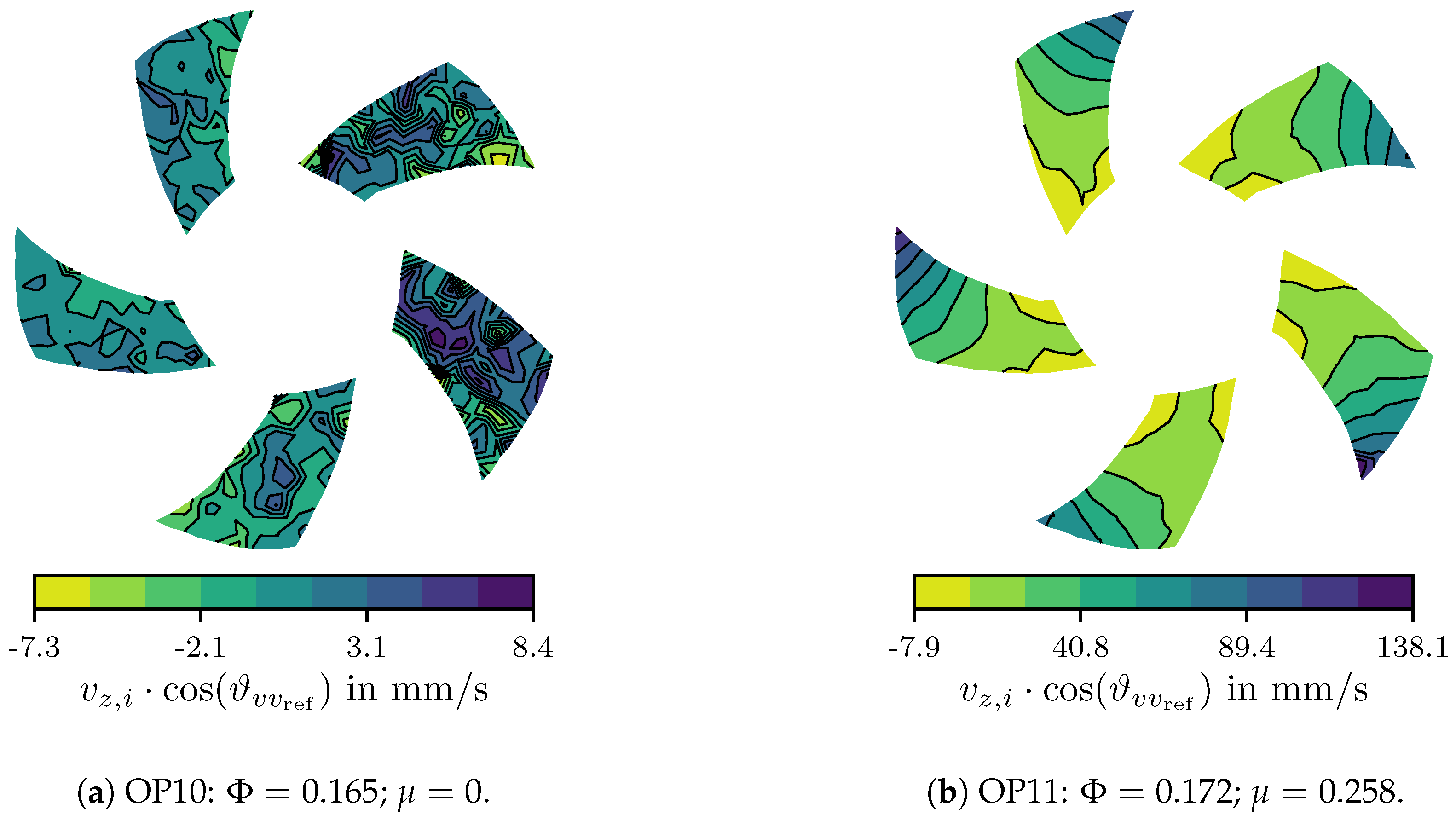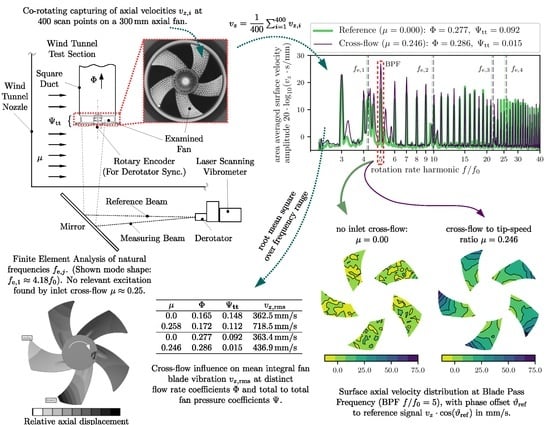Axial Fan Blade Vibration Assessment under Inlet Cross-Flow Conditions Using Laser Scanning Vibrometry †
Abstract
:1. Introduction
2. Materials and Methods
2.1. Wind Tunnel Fan Test Rig
2.2. Laser Scanning Vibrometry
2.3. Numerical Setup for Natural Frequency Computation
3. Results and Discussion
3.1. Reference Results and Computed Mode Shapes
3.1.1. Natural Frequencies
3.1.2. Spectral Decomposition of the Surface-Averaged Velocity Amplitude
3.1.3. Mode Shapes at Natural Frequencies
First Natural Frequency Mode
Second Natural Frequency Mode
3.2. Inlet Cross-Flow Influence on Fan Blade Vibration
3.2.1. Spectral Decomposition of Surface-Averaged Vibration
3.2.2. Motion Patterns at Dominant Peaks
4. Conclusions
Acknowledgments
Author Contributions
Conflicts of Interest
Abbreviations
| ACC | Air-cooled condenser |
| LSV | Laser scanning vibrometry |
| FEM | Finite element method |
| OP | Operating point x with () or without () cross-flow |
References
- Maulbetsch, J.S. Cost/Performance Comparisons of Water Conserving Power Plant Cooling Systems. In Proceedings of the International Mechanical Engineering Congress and Exposition, Denver, CO, USA, 11–17 November 2011; pp. 385–390. [Google Scholar]
- Duvenhage, K.; Kröger, D. The influence of wind on the performance of forced draught air-cooled heat exchangers. J. Wind Eng. Industr. Aerodyn. 1996, 62, 259–277. [Google Scholar] [CrossRef]
- Owen, M.; Kröger, D.G. Contributors to increased fan inlet temperature at an air-cooled steam condenser. Appl. Therm. Eng. 2013, 50, 1149–1156. [Google Scholar] [CrossRef]
- Butler, C.; Grimes, R. The effect of wind on the optimal design and performance of a modular air-cooled condenser for a concentrated solar power plant. Energy 2014, 68, 886–895. [Google Scholar] [CrossRef]
- Salta, C.; Kröger, D. Effect of inlet flow distortions on fan performance in forced draught air-cooled heat exchangers. Heat Recovery Syst. CHP 1995, 15, 555–561. [Google Scholar] [CrossRef]
- Owen, M.T.F.; Kröger, D.G. An Investigation of Air-Cooled Steam Condenser Performance Under Windy Conditions Using Computational Fluid Dynamics. J. Eng. Gas. Turb. Power 2011, 133, 064502. [Google Scholar] [CrossRef]
- Borghei, L.; Khoshkho, R.H. Computational fluid dynamics simulation on a thermal power plant with air-cooled condenser. Proc. Inst. Mech. Eng. A J. Power Energy 2012, 226, 837–847. [Google Scholar] [CrossRef]
- Zhang, X.; Chen, H. Performance Forecast of Air-Cooled Steam Condenser under Windy Conditions. J. Energy Eng. 2015, 142, 04015010. [Google Scholar] [CrossRef]
- Xiao, L.; Ge, Z.; Du, X.; Yang, L.; Xu, Z. Operation of air-cooling CHP generating unit under the effect of natural wind. Appl. Therm. Eng. 2016, 107, 827–836. [Google Scholar] [CrossRef]
- Fourie, N.; van der Spuy, S.; von Backström, T. Simulating the effect of wind on the performance of axial flow fans in air-cooled steam condenser systems. J. Therm. Sci. Eng. Appl. 2015, 7, 021011. [Google Scholar] [CrossRef]
- Thiart, G.; von Backström, T. Numerical simulation of the flow field near an axial flow fan operating under distorted inflow conditions. J. Wind Eng. Industr. Aerodyn. 1993, 45, 189–214. [Google Scholar] [CrossRef]
- Meyer, C. Numerical investigation of the effect of inlet flow distortions on forced draught air-cooled heat exchanger performance. Appl. Therm. Eng. 2005, 25, 1634–1649. [Google Scholar] [CrossRef]
- Van der Spuy, S.; von Backström, T.; Kröger, D. Using computational fluid dynamics to simulate multiple axial flow fans in air-cooled steam condensers. In Proceedings of the ASME 2011 Power Conference Collocated with JSME ICOPE 2011, Denver, CO, USA, 12–14 July 2011; pp. 375–383. [Google Scholar]
- Van der Spuy, S.J.; von Backström, T.W. An evaluation of simplified CFD models applied to perimeter fans in air-cooled steam condensers. Proc. Inst. Mech. Eng. Part A J. Power Energy 2015, 229, 948–967. [Google Scholar] [CrossRef]
- Hotchkiss, P.; Meyer, C.; von Backström, T. Numerical investigation into the effect of cross-flow on the performance of axial flow fans in forced draught air-cooled heat exchangers. Appl. Therm. Eng. 2006, 26, 200–208. [Google Scholar] [CrossRef]
- Bredell, J.; Kröger, D.; Thiart, G. Numerical investigation into aerodynamic blade loading in large axial flow fans operating under distorted inflow conditions. R D J. SAIMechE 2006, 22, 11–17. [Google Scholar]
- Muiyser, J.; Els, D.N.; van der Spuy, S.J.; Zapke, A. The determination of fan blade aerodynamic loading from a measured response. In Proceedings of the ASME Turbo Expo 2015: Turbine Technical Conference and Exposition, Montreal, QC, Canada, 15–19 June 2015; Volume 1. [Google Scholar]
- Muiyser, J.; Els, D.N.; van der Spuy, S.J.; Zapke, A. Investigation of Large-Scale Cooling System Fan Blade Vibration. In Proceedings of the ASME Turbo Expo 2014: Turbine Technical Conference and Exposition, Düsseldorf, Germany, 16–20 June 2014. [Google Scholar]
- Heinemann, T.; Bakeberg, C.; Lienhart, H.; Becker, S. Total Pressure Measurements Behind an Axial Ventilator Using a Kiel Probe Array. In Notes on Num Fluid Mech & Multidisc Design; Dillmann, A., Heller, G., Krämer, E., Kreplin, H.P., Nitsche, W., Rist, U., Eds.; New Res in Num & Exp Fluid Mech IX; Springer: Berlin, Germany, 2014; Volume 124, pp. 573–581. [Google Scholar]
- Heinemann, T.; Becker, S. Experimental Investigation of Ambient Wind Influence on the Performance of Axial Fans. In Proceedings of the ASME Turbo Expo 2014: Turbine Technical Conference and Exposition, Düsseldorf, Germany, 16–20 June 2014. [Google Scholar]
- BIPM Joint Committee for Guides in Metrology. Evaluation of Measurement Data—Guide to the Expression of Uncertainty in Measurement JCGM 100: 2008. Available online: http://www.bipm.org/en/publications/guides/gum.html (accessed on 13 March 2017).
- Fioretti, A.; Di Maio, D.; Ewins, D.; Castellini, P.; Tomasini, E. Deflection Shape Reconstructions of a Rotating Five-blade Helicopter Rotor from TLDV Measurements. In AIP Conference Proceedings; AIP: Melville, NY, USA, 2010; Volume 1253, pp. 17–28. [Google Scholar]
- Johansmann, M.; Fritzsche, M.; Schell, J. A New Method for Measurement of Rotating Objects Utilizing Laser Doppler Vibrometry Combined with an Optical Derotator with Focus on Automotive Applications; SAE Technical Paper; SAE International: Troy, MI, USA, 2011. [Google Scholar]
- Muiyser, J.; Van der Spuy, S.; Els, D.; Zapke, A. Measurement of air flow and blade loading at a large-scale cooling system fan. R D J. S. Afr. Inst. Mech. Eng. 2014, 30, 30–38. [Google Scholar]











| OP1 | OP10 | 0.0 | ||
| OP11 | ||||
| OP2 | OP20 | 0.0 | ||
| OP21 |
| in m/s | in Hz | in m3/s | in Pa | ||
|---|---|---|---|---|---|
| OP1 | OP10 | 0.0 | |||
| OP11 | |||||
| OP2 | OP20 | 0.0 | |||
| OP21 |
| j | 1 | 2 | 3 | 4 | 5 | 6 | 7 | 8 |
|---|---|---|---|---|---|---|---|---|
| in | 184.7 | 432.8 | 942.8 | 1123 | 1657 | 1948 | 2034 | 2190 |
| (FEM) | 4.181 | 9.796 | 21.34 | 25.42 | 37.51 | 44.09 | 46.04 | 49.57 |
| (OP10) | 4.269 | 10.00 | 21.79 | 25.95 | 38.29 | 45.02 | 47.01 | 50.61 |
| (OP11) | 4.491 | 10.52 | 22.92 | 27.30 | 40.29 | 47.36 | 49.45 | 53.25 |
| (OP20) | 4.181 | 9.796 | 21.34 | 25.42 | 37.51 | 44.09 | 46.04 | 49.57 |
| (OP21) | 4.254 | 9.968 | 21.71 | 25.86 | 38.16 | 44.86 | 46.85 | 50.44 |
| j | in Hz | Distinct Associated Frequency in Hz | ||||
|---|---|---|---|---|---|---|
| Blade 1 | Blade 2 | Blade 3 | Blade 4 | Blade 5 | ||
| 1 | 184.7 | 184.96 | 184.70 | 184.72 | 184.73 | 184.77 |
| 2 | 432.8 | 432.71 | 432.80 | 432.84 | 432.88 | 432.94 |
| 3 | 942.8 | 942.02 | 942.10 | 943.03 | 943.17 | 943.57 |
| 4 | 1123 | 1122.4 | 1122.5 | 1122.6 | 1123.6 | 1123.6 |
© 2017 by the authors. Licensee MDPI, Basel, Switzerland. This article is an open access article distributed under the terms and conditions of the Creative Commons Attribution (CC BY) license (http://creativecommons.org/licenses/by/4.0/).
Share and Cite
Heinemann, T.; Becker, S. Axial Fan Blade Vibration Assessment under Inlet Cross-Flow Conditions Using Laser Scanning Vibrometry. Appl. Sci. 2017, 7, 862. https://doi.org/10.3390/app7080862
Heinemann T, Becker S. Axial Fan Blade Vibration Assessment under Inlet Cross-Flow Conditions Using Laser Scanning Vibrometry. Applied Sciences. 2017; 7(8):862. https://doi.org/10.3390/app7080862
Chicago/Turabian StyleHeinemann, Till, and Stefan Becker. 2017. "Axial Fan Blade Vibration Assessment under Inlet Cross-Flow Conditions Using Laser Scanning Vibrometry" Applied Sciences 7, no. 8: 862. https://doi.org/10.3390/app7080862





